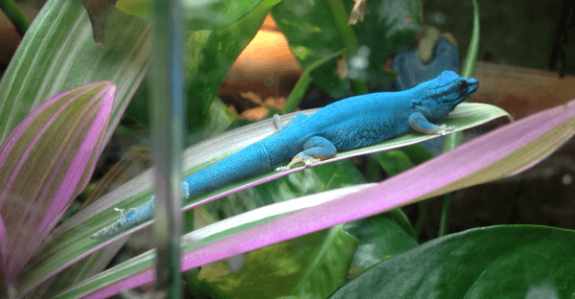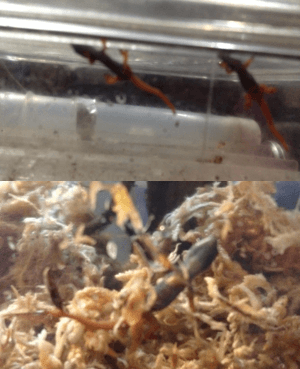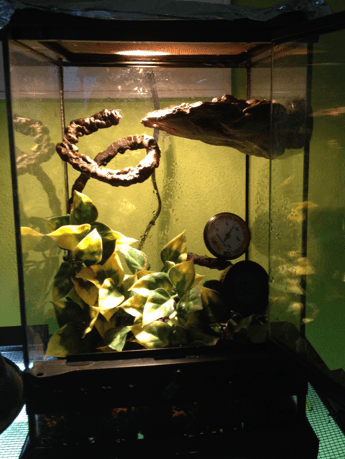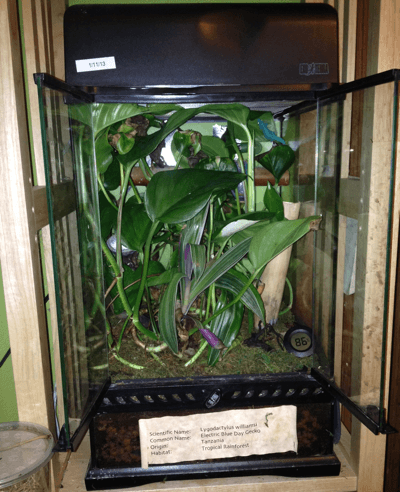It’s natural for gecko keepers, like anyone else, to publicize their successes and avoid discussion of their failures. Failures are frustrating and even somewhat embarrassing. Discussing them publicly also leaves one open to criticism. Despite having all these feelings, I’ve decided to write about my failure this past year to successfully breed Lygodactylus williamsi — electric blue day geckos.
Acquiring the Stock
I’ve been fascinated with L. williamsi and the males’ gorgeous coloring for years and figured eventually I’d get some. About a year and a half ago I was lucky enough to acquire a proven male from craigslist along with lighting and two 12″x12″18″ exo-terras for an amazing price. About 3 months after “King” was installed in my home, I bought a female L. williamsi from Leann Christenson (of daygecko.com). After the new gecko finished her quarantine period, I put her with the male and things seemed to go well, until she died unexpectedly several months later. I could find no reason for her death. She hadn’t lost weight, had no bite or scratch marks on her and had shown no signs of stress. I felt terrible telling Leann what had happened since she had entrusted one of her geckos to me. She was amazingly supportive and offered me another female in return for a male offspring. Last summer, the second female arrived. She settled in without any problems, responded well to the male and laid 5 clutches of eggs between September and December 2013. Once again, in February 2014, she died with no warning and no sign of any problem. The male continues to be healthy.

Incubation
The female was provided with floral tubes for laying and with one exception, laid all her eggs in the tubes, which were then placed in the incubators. The eggs were incubated in three locations: four eggs were incubated for female at 75F, four were incubated for male at 83F and two were laid in the cage and incubated in situ. Seven of the ten eggs hatched – four from the female incubator, two from the male incubator and one from the parents’ cage. The first two hatched in November 2013, and the last 5 hatched between Feb. 5 and Feb. 14 2014. Incubation times ranged from 51-123 days.

Hatchlings
The first two hatchlings were kept the same way I had successfully kept the E. agricoli I had previously hatched. They were placed in a 32 ounce deli cup whose cover had gauze-covered air holes. Moist sphagnum moss and a piece of cork bark were placed in the deli cup and the entire cup was put in my P. klemmeri cage under the basking light. The container was misted twice daily. At day 3, CGD and small crickets were provided. The hatchlings started out active and energetic and within 10 days both had died. I consulted with Leann, who recommended a glass set-up similar to that of the parents with access to a warm basking light, good hydration and daubs of peach baby food around the cage to enable them to find food wherever they happened to be.
Accordingly, I set up an Exo-terra nano (8″x8″x12″) with a compact florescent in a small canopy, a halogen puck light, a Magnaturals” ledge and twisted fake vine to provide climbing and basking spots and a fake plant to provide hiding spaces. I installed a hygrometer, misted frequently and fed peach baby food and small (1/8″) crickets. Once again, within 2 weeks, the remaining 5 babies had died.

What Was the Problem?
We couldn’t understand what had gone wrong. The set-up seemed to be similar to that of other keepers who have successfully raised L. williamsi. The hatchlings appeared to be healthy at birth. In cases like this, one starts grasping at straws to figure out what the problem is and what needs to be changed.
I can think of only one possibility: all the hatchlings were produced during the New England winter. While the temperatures in the enclosures were appropriate, the winter forced hot air heating made humidity difficult to maintain. The last misting of the night occurred at 2-3am. By the time of the first morning misting, only 5-6 hours later, the hygrometer indicated that the humidity had dropped below 40%. The halogen light provided heat, but also may have desiccated the delicate hatchlings. I don’t know that I ever saw any of the hatchlings eating; it’s possible that the low humidity interfered with digestion.

Future Plans
Although in February I was saying “never again”, I just can’t give up. I plan to acquire another female at the end of the summer. She will remain separated from the male except for a brief period for mating (after her quarantine). This, and the provision of a dish of calcium without D3 (and D3 supplementation through diet) should reduce any possible stress caused by over-breeding. The exo-terra nano is being maintained currently as a terrarium with plants in order to maximize humidity. The biggest change is that breeding will take place during the spring and summer of 2015, rather than in the fall and winter. Currently the humidity in the nano ranges from 50-80%.
I’m still hoping I will succeed in my plans to breed L. williamsi. If I’m successful, I will redouble my efforts to develop an L. williamsi breeders list in the U.S. (see the Gecko Time article about this endeavor) so prospective breeders can obtain unrelated L. williamsi pairs.
Wish me luck. Any comments or suggestions to increase my success are welcome.


Too bad, but it is said that the only real failure is failing to learn from your mistakes. Good luck next season!
Hopefully you will have better luck next year, did you provided them with any UV-B lighting?
Am I wrong or the temperatures are swapped? Aren’t females incubated at lower temperatures?
Good luck with next season, I had recently two beautiful kimhowelli hatchlings, they didn’t make past the 3rd day, in my case ants got in their enclosure and killed them since they couldn’t run away.
Thanks for catching my male/female error. I just fixed it. The confusion was due to the fact that the male L. williamsi were incubating in my female leo incubator since leos incubate at a higher temperature than williamsi.
Aliza
What a beautiful species! Thanks for documenting the process and trying again when it’s appropriate!
I caught hell from an ignoramus [whom I will not name] for breeding my williamsi in 18in ExotTerra cubes with dart frogs. Supposedly I was “cramming” the geckos with the vicious dart frogs. II have found, however the frogs like the higher humidity and lower temps towards the bottom, [75F or less and ~80%] while the Lygo williamsi/kimhowelli enjoy the higher temps and less humidity towards the top [90F+ and ~40-50%], so they did not interact often.
I put my females through a cool down period every year with NO males. Some say this is bad since they tend to pair for life [supposedly], but I often wonder if aggressive males are the source of trouble. Wonder what UVB light you use, I use Repti-Glo 5.0s. Also wonder what supplements. I try to get calcium without D3 and add vitamins only once or twice a week [mixed in fruit]. Once upon a time I would catch flies since they seem to love flies but I will not risk houseflies being vectors anymore for pathogens. Instead I feed the dusted fruitflies gut fed with red peppers, cherries, catalope. [Have to keep fruitflies around anyway for hatchlings, chameleon hatchlings and of course dart frogs. And of course crickets and wish I could find phoenix worms around here easily..
My problem is too many males. I have not been able to get my females to lay their eggs on anything but the glass, [although once in a while in hides.] Right now I have four of my six females out of their 18in cubes with plenty of bamboo and bark hides in 12in cubes, HOPING they will lay them in there, and if they don’t, then I will take the whole cage and keep it below 80F. [taking the females out of course. Are you certain for 100% that temps lower than 82F produce only females? Any input on the temp appreciated. I only want to produce females at this point. Usually I would not keep my breeding females in anything smaller than a 18in cube BUT since these four are quite gravid I wanthem to lay their clutches in these 12in cubes so I can get all females IF lower temps = females. Would love to have eight hatchling females in a few months.
I recently sold four excess males to a FakeBook friend in Florida. I thought the idea of them getting real sun part of the year when it’s not too hot wold be good for them and she is in the part of the country where it’s far easier to find Lygodactylus as well as any other reptile. She claims she will be keeping two of them in screen cages when the temp is below 90F and above 60F in the sun, which might turn out great. Who knows?
I keep my hatchlings in a 12in cube. Right now I only have one williamsi, but four kimhowelli. There is a compact 5.0 UVB bulb under a dome light which is taped to the top. It is the only source of light and heat. The temp doesn’t quite get over 90F athe top and center but the humidity is below 60% there. Towards the bottom the temp is ~70F and their is plenty of water for them to drink since it beads up down there. Have a video of it on uTube.
https://www.youtube.com/watch?v=Nw2yQb3Gg8o
DON’T give up. They breed prolifically but are quite delicate. I have had ______ spiders eat my hatchlings and therefor have to periodically cleanse my cages of ________! house spiders. I think the common “rolly pollies” are toxic to them as well [not sure] since I have had geckos go down to the bottom grab something and then suddenly die within a day or two. I try to catch “rolly pollies” by putting in a tin can [catfood/tuna] with some food and they can get in but not out. The geckos will get out on me and I can not catch them. But in the end they’re worth it, expecially since their homerange is under seige from the stupidity of our species. Call me anytime you wish Aliza, you have my number. If I can get all females coming out I will send you them cheap as soon as I can get up to ten breeding females. Only have six now.
Thanks for the info. I tape florist tubes to the sides of the cage and the female has always laid in those. Then I can remove the whole tube and put it in the incubator. I have been told that low 80’s will yield females but haven’t gotten any to the point of being able to sex them. I don’t use UVB, but provide vitamin D3 via Repashy calcium plus and have had no problems with these guys as well as with my other day geckos who are 7 and 8 years old.
ALiza
Similar things happened to me when I started keeping Lygodactylus picturatus fife years ago.
I started with a couple from Tanzania but during the quarantine and after she laid two eggs she died in June. I had no idea how to handle the eggs so I left them dry under a sunny window (no direct sunlight) in its box. After month I forgot them and was surprised to find two tiny geckos when I looked at it one day. I put them in a cricket box and started feeding with baby crickets and supplement vitamins (Necton REP) but without UV and under dry conditions. Both grew up and became females without any problems. Both laid eggs and I found babies every year but it was impossible to bring them up. They stopped eating (Drosophila) after one or two weeks and died. The difference in keeping was only the food the humidity and the season. Last hot summer I found some juveniles in my terrarium and wondered how they could survive. Then I found a lot of baby crickets in there. After raising 12 babies under dry and quarantine conditions this year I am convinced that bacteria count under moist conditions (perhaps caused of a lack of UV) and non optimum nutrition and supplementary of vitamins are responsible for the failure. Now I raise my babies with newborn crickets and wheat greenfly with Korvimin supplementation and an UV tube without any problems and minimum losses.
Hope you find the solution!
Thanks for your comment. It’s interesting that you had better success with the dry conditions because I would have thought that low humidity would dehydrate them. I’m looking forward to trying again next (hot) summmer.
Hi Aliza,
I’m wondering how the breeding went this spring/summer, if it was successful and if you have any advice off the back of it?
I live in the UK and getting hold of captive bred williamsi has proved a nightmare! I now have 1 x adult male and 3 x juveniles – 3-4 mths (hoping for at least 1 female from them) arriving shortly. I’m really keen to try and breed them (assuming I don’t end up with 4 males!)
The main advice that the breeder I’ve bought them from has given is don’t try and breed them until the female is at least 2 years old – he says he’s had a lot more success working it that way (don’t know if that helps you at all?)
Thanks
Nathan
Thanks for your interest. After having yet another healthy, fat female die unexpectedly (before even being with a male) I gave up and have turned my attention to other projects that are working out better. Good luck in your endeavors.